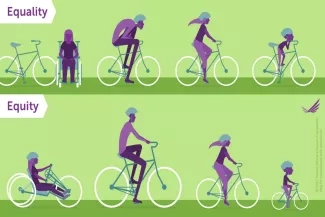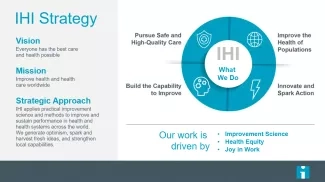Why It Matters
June 30, 2020 is Derek Feeley’s last day as IHI’s President and CEO. As we welcome Dr. Kedar Mate to the position, Feeley shares some reflections on his time as IHI’s chief executive in the following interview.
You’ve been with IHI since 2013 and have served as CEO since 2015. How has being a leader at IHI changed you? How have you influenced IHI?
People used to ask me all the time, “Derek, what is it you do?” [laughs]. Eventually, I began to understand that they weren’t asking me what’s on my job description. They were asking what I prioritize as a leader.
My job at IHI has been to 1) create an environment where people can thrive and 2) make the right decisions easier to take. I ask myself whether I’m doing these things every day. I’ve learned a little bit about how best to do these things over the last 20 years, but I’ve learned the most over the last five years at IHI.
One of the most important lessons being at IHI has reinforced for me is that not everybody automatically has the same opportunities to thrive. It’s like the graphic that depicts the difference between equality and equity (see Figure 1).

People need different things to reach their full potential in an organization. I didn’t fully appreciate that before I came to IHI.
On making the right decision easier to take, I believe I’ve contributed to IHI’s constancy of purpose. Keeping the organization focused on the mission and backing that up with a solid strategic plan have been crucial. Mission and purpose without strategy and plan are just words on a page.
IHI gets pulled in all sorts of directions and people ask us to do all sorts of things. Part of what I’ve tried to instill in the organization is the understanding that we have choices. The reason we have a strategy is to help us make those choices. By and large, we’ve made good choices about where to focus our energies, where we can make the most impact, and how we can best help our partners and customers do the work they want to do.
People sometimes ask me, “Is it easier to lead an organization of 200 or a bigger organization?” This is because, before IHI, I was leading 142,000 people [as Chief Executive of the National Health Service (NHS) in Scotland]. In some ways it’s easier and in some ways it’s harder. It’s easier because you can communicate with everybody face to face. But what makes it harder is [also] that you’re able to communicate with everybody face to face [laughs].
I’ve made it my business to try to get to know everyone at IHI and for them to get to know me. That makes leadership both easier and harder because you care much more about every individual, especially about creating an environment where people can thrive. Because I know the people at IHI, it matters even more to me that I’m able to do that for every individual. It’s sometimes challenging, but it’s important that leaders care. I haven’t shied away from that.
You’ve said that organizations should learn as much from their successes as from their failures. Which IHI successes taught you the most and which challenges taught you the most?
One thing I’ve learned is that there’s a synergy between health and health care that I’m not sure we’ve always optimized at IHI. Our mission is to improve health and health care worldwide. We’ve been at our best when we put those two things together.
In one of the very first IHI National Forum keynotes I ever gave, one of the messages we were trying to give is that we should always be thinking about health care’s contribution to health and health’s contribution to health care. For example, how can we focus on prevention, social mobilization, the social determinants of health, and what Don Berwick calls the moral determinants of health.
Looking back over some of what we’ve done in our equity journey, we’ve made some good progress, but there have been some missteps along the way when we didn’t uplift the voices of people of color in a way that we could and should have. In my early development as a leader around some of these issues, I did too much talking for people of color and too little listening to them. That was an important example of learning from failure that helped us to make progress.
Another challenge is that we sometimes see our improvement work as a purely technical exercise. We often forget the human part. If we go back to W. Edwards Deming and the four domains of the Theory of Profound Knowledge, we don’t generally spend enough time on the psychology domain. That has been important for us to learn. The work led by Kate Hilton and Alex Anderson to develop the IHI Psychology of Change Framework will help prepare IHI for the future.
When you decided to leave IHI, you could not have predicted something like COVID-19. What would you say the global crisis has taught you about being a leader?
I’m trying hard not to feel guilty about leaving the organization right now. At the same time, I’m leaving for reasons not disassociated from COVID-19. I’ve returned to Scotland to help take care of my parents. They’re at higher risk of COVID-19, so it makes it even more important to do what I’ve done.
I’ve been talking to many leaders around the world and it’s become clear that we need to do three things now and during any crisis:
- Be transparent. This is no time for sugarcoating. Jim Collins would call this “confronting the brutal facts.” You have to tell people how it is and do it with confidence. Leaders should be out and communicating with people and not sitting back waiting to be asked.
- Be the voice of calm. People need calm in times of uncertainty. As you’re being honest, open, and transparent about the reality of the situation, leaders need to convey the sense that you’re confident you can manage this crisis. You need to send the message that you can see a path from current state to better. The more a leader can present that in a calm, measured, and empathic way, the more positively people are likely to respond.
- Be together. Leaders shouldn’t lead through a crisis from a bunker. They should be open to learning and open to other people’s experiences. Bearing in mind what COVID-19 has meant for us around physical distancing, we have to resist the tendency to hunker down. Part of the leadership job in COVID-19, and in any crisis, is to ask, “How can I get support? How can I do this with togetherness rather than individually?” It’s not a time for heroism. It’s a time for humility and saying, “Look, I don’t have all the answers. But I’m going to connect with this person over here because I trust them. I think they may have some of the answers I need and I’m going to help them, too.”
For me, one of the most enduring lessons in Jim Collins’ Good to Great was the idea that exceptional leaders plan for their own succession. What are you doing to make sure you leave IHI in good hands?
IHI’s mission is to improve health and health care worldwide. I have always put that mission first. We’ve recruited a board that believes in the mission. We’ve recruited people who believe in the mission. IHI’s mission will survive me. Quite frankly, I think IHI’s mission will also survive my successor. This is just what we do. Our belief in our mission is the glue that binds us together at IHI.

The second thing I've tried to do, alongside the organization, is develop a set of strategic goals that underpin that mission, that help us direct our activities toward things that people can get behind, in service of impact, reach, and vitality.
I have always wanted to recreate our values as an organization and we had an opportunity to do that. We created a diverse team of people within the organization to develop those values. I feel as if they’re part of my fabric now as a leader, but I didn’t create the values. I was part of the team and that’s all I was. Now I think you could ask anybody at IHI, “What are IHI’s values as an organization?” People can easily tell you that they’re courage, love, equity, and trust.
These are not my values as the chief executive. They’re our values as an organization. They’re strong and powerful. My full expectation is that everybody at IHI will continue to act with courage, love, equity, and trust long after I’m finished as the CEO.
You may also be interested in:
